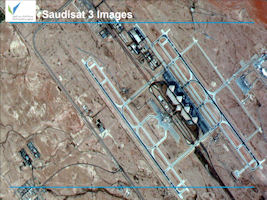Saudi Arabia and Earth Observation Systems
Earth Observation (EO) is a well established scientific and technical field. In many ways, it is a common link between the major areas of the space sector as it relies on the fundamental technical platforms that support these areas. There are generations of imaging satellites dating back to the 1960’s that provide detailed data on the earth’s topography and atmospheric and weather system dynamics. Due to the increasing sophistication of current and planned generations of imaging satellites, there is a growing set of applications derived from earth observation platforms. The applications include, for example, monitoring biosphere changes, solid earth topography, interior characteristics, and natural resources, and improving geographical information systems.
Remote sensing technology and its applications have been quickly advancing in recent years. Such advances include improved spectral and spatial resolutions, as well as high data delivery rate and frequency of revisits. This has led to an increased number of applied projects and advanced research activities in Earth observation and the study of Earth resources.
In recognition of the viability of this technology, the Saudi Centre for Remote Sensing (SCRS) was established in 1986 as a division of the Space Research Institute. The responsibilities of SCRS include data reception and distribution to various users, promoting the use of satellite data and building a rich data archive. In support of this effort, SCRS signed a number of agreements to receive satellite data from various satellites. Currently, SCRS receives and distributes satellite images from the Land Remote Sensing Satellite (Landsat), SPOT-1, SPOT-2 and SPOT-4, RADARSAT, the Indian Remote Sensing Satellite (IRS-1C and IRS-1D) and National Oceanic and Atmospheric Administration (NOAA) satellites. The coverage area of the SCRS reception ground station extends to a radius of 2,700 km, with about 23 million km2 of surface area coverage. The ground station is capable of simultaneously receiving multiple satellites and it is fully automated for satellite tracking reception. With the recent upgrading of its reception and image analysis and processing capabilities, SCRS is now considered one of the leading centres worldwide.
SaudiSat 3, launched by Russia from Tyuratam Missile and Space Center, Kazakhstan (Also known as Baikonur Cosmodrome) on 17 April 2007, is a 200 kg spacecraft that carries a high resolution imager, built in collaboration with KACST's faculty and students. SaudiSat 3 uses high resolution imagers provided by SUNspace in South Africa for Space Research Institute of KACST.
King Abdulaziz City for Science and Technology (KACST) in the Saudi capital Riyadh, announced the successful launch of the Saudi Sat 5A and the Saudi Sat 5B satellites on Friday, December 7, 2018 at 12:12 pm Beijing time on the Long March 2D from the Jiuquan Satellite Launch Center of the People’s Republic of China. The two satellites Saudi Sat 5A and Saudi Sat 5B will be used to provide government agencies with high-resolution satellite images similar to those in developed countries for use in various fields of development. The two satellites will be managed and operated from an advanced control station located at the headquarters of (KACST).
Prince Turki bin Saud bin Mohammed, President of King Abdulaziz City for Science and Technology extended his congratulations to the Custodian of the Two Holy Mosques King Salman bin Abdulaziz Al Saud and to Saudi Crown Prince Mohammed bin Salman bin Abdulaziz on the launch according to SPA.
Prince Turki said that the achievement is conducted by support and guidance of King Salman and the follow-up and care of the Crown Prince, stressing that this achievement comes as a complement to many achievements in the fields of space and aviation in line with vision 2030 in Saudi Arabia. This achievement comes as a result of the efforts made by KACST over the years in the transfer and development of many advanced technologies, including satellite technologies and the construction of national cadres capable of dealing with these technologies and the establishment of advanced infrastructure, enabling the City to develop and manufacture satellites Saudi Sat 5A and Saudi Sat 5B in its national hands factories.
|
NEWSLETTER
|
| Join the GlobalSecurity.org mailing list |
|
|
|




